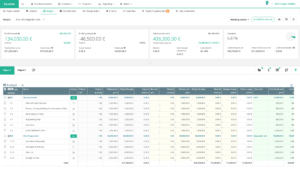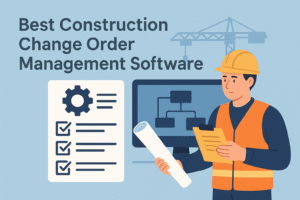In the ever-competitive construction industry, maintaining profitability is not just an aspiration; it’s a necessity. With fluctuating demand and rapidly changing market dynamics, construction businesses must stay ahead of the curve to ensure their operations remain profitable and sustainable. This article aims to provide a comprehensive guide on increasing your construction company’s profit margin, focusing on actionable insights and strategies that can be readily implemented.
As a construction company owner, you understand that the key to success lies in maximizing the profit margin of your business. However, achieving this goal can be challenging, especially when faced with numerous factors that can impact profitability, such as labor costs, material prices, and competition. This article will help you navigate these complexities by providing valuable information on average profit margins in the construction industry, insights into calculating profit margin, and various approaches to optimize your business’s profitability.
Whether you are an experienced construction company owner or a new entrepreneur in the field, this article will serve as a valuable resource to help you maximize your profits. So, let’s dive in and explore how you can transform your construction business into a more profitable venture.
Table of Contents
II. Understanding Average Profit Margins in Construction
A. Defining profit margin
Profit margin is a crucial financial metric that represents the percentage of revenue remaining after accounting for the costs and expenses associated with running your construction business. It allows you to gauge your company’s financial health and assess its performance relative to competitors in the industry.
B. Why profit margin matters
Understanding and monitoring profit margins is vital for construction company owners, as it helps identify areas for improvement and measure the effectiveness of current strategies. A healthy profit margin ensures that your business can grow, invest in new opportunities, and weather potential economic downturns.
C. Industry standards for profit margins
Profit margins in the construction industry tend to vary based on the type and scale of the projects undertaken, as well as the company’s size and market position. However, some benchmarks can be used as a point of reference:
- Gross profit margin: Typically falls between 10% and 20% for most construction companies, with the higher end being more desirable.
- Net profit margin: Averages around 2% to 6% in the construction industry, with a higher percentage indicating better financial health.
Keep in mind that these numbers are general guidelines and that your company’s specific circumstances may differ.
D. Factors affecting profit margin in construction
Several factors can influence your construction company’s profit margin. Understanding these factors can help you optimize your strategies and make informed decisions. Some of these factors include:
- Labor costs: High labor costs can directly impact your profit margins, making it essential to manage them efficiently.
- Material prices: Fluctuating material costs can affect the overall profitability of a project. Keeping track of market trends and negotiating with suppliers can help minimize this impact.
- Competition: A competitive market can pressure your company to reduce prices, potentially affecting profit margins.
- Project size and complexity: Larger or more complex projects may entail higher profit margins due to economies of scale and the specialized expertise required.
- Market conditions: Economic factors, such as interest rates and regional construction demand, can also impact your company’s profitability.
By understanding these factors, you can make informed decisions to improve your construction company’s profit margin and ensure long-term success.
III. Calculating Profit Margin
A. Revenue vs. expenses
To calculate profit margin, you must first understand the difference between revenue and expenses. Revenue is the total income generated by your construction company through completed projects and services rendered. Expenses, on the other hand, are the costs incurred to run your business, including labor, materials, equipment, and overhead costs.
B. Gross profit margin formula
Gross profit margin is a measure of your company’s financial health before considering operating expenses, taxes, and other indirect costs. To calculate gross profit margin, use the following formula:
Gross Profit Margin = (Total Revenue – Cost of Goods Sold) / Total Revenue × 100
Cost of Goods Sold (COGS) refers to the direct costs of producing the goods or services offered by your construction company, including labor and material expenses.
C. Net profit margin formula
Net profit margin is a more comprehensive measure of profitability, taking into account all expenses associated with running your business. To calculate net profit margin, use the following formula:
Net Profit Margin = (Total Revenue – Total Expenses) / Total Revenue × 100
Total expenses include direct costs (COGS), as well as indirect costs, such as administrative and overhead expenses, taxes, and interest.
D. Example calculations
Consider a construction company with the following financial data:
Total Revenue: $1,000,000
Cost of Goods Sold: $700,000
Total Expenses: $900,000
Gross Profit Margin = ($1,000,000 – $700,000) / $1,000,000 × 100 = 30%
Net Profit Margin = ($1,000,000 – $900,000) / $1,000,000 × 100 = 10%
In this example, the company has a gross profit margin of 30% and a net profit margin of 10%. Comparing these numbers with industry standards can help you assess your construction company’s performance and identify areas for improvement.
IV. Strategies to Increase Profit Margin
A. Reducing costs
- Streamlining operations: Review your construction processes and identify areas where efficiency can be improved. This may include eliminating redundancies, reducing waste, and optimizing resource allocation.
- Implementing cost-effective technologies: Adopting new technologies, such as project management software, estimating tools, and Building Information Modeling (BIM), can help reduce costs by improving accuracy and efficiency.
- Improving supplier negotiations: Develop strong relationships with suppliers and negotiate better deals on materials and equipment. Consider bulk purchasing and long-term contracts to secure lower prices.
B. Increasing revenue
- Marketing strategies: Develop and implement targeted marketing campaigns to increase brand awareness and generate more leads. Utilize both traditional and digital marketing channels, including social media, email marketing, and content marketing.
- Diversifying services: Expand your service offerings to cater to a broader range of clients and markets. This may include providing design-build services, facility management, or specialized construction services.
- Expanding market reach: Explore new geographic regions and market segments to increase your client base and revenue potential. Conduct thorough market research to identify promising opportunities.
C. Enhancing productivity
- Employee training and development: Invest in the continuous development of your workforce through training programs, workshops, and certifications. A well-trained and skilled team can complete projects more efficiently and effectively.
- Efficient project management: Utilize project management best practices to ensure that projects are completed on time and within budget. Establish clear communication channels, set realistic deadlines, and monitor progress regularly.
- Adopting lean construction principles: Implement lean construction methodologies to minimize waste and improve overall project efficiency. This includes streamlining workflows, eliminating non-value-added activities, and optimizing resource utilization.
D. Optimizing pricing strategy
- Value-based pricing: Set prices based on the value delivered to the client, taking into account factors such as project complexity, specialized expertise, and market demand.
- Competitive pricing: Analyze competitor pricing and market trends to ensure your pricing strategy is competitive while maintaining profitability.
- Penetration pricing: Consider offering lower prices for new services or markets as an introductory strategy to gain market share. Once established, gradually adjust prices to better reflect your company’s value proposition.
By implementing these strategies, you can increase your construction company’s profit margin, ensuring long-term success and growth in the competitive construction industry.
V. Leveraging Technology and Data for Improved Profitability
A. Importance of data-driven decision-making
In today’s digital age, leveraging technology and data can significantly improve your construction company’s profitability. Data-driven decision-making allows you to identify trends, uncover inefficiencies, and make informed choices based on accurate information. This can lead to better project management, cost control, and overall business performance.
B. Examples of construction software and tools
There are various construction software and tools available that can help you optimize your company’s operations and make data-driven decisions. Some of these include:
- Project management software: Tools like Procore, PlanGrid, and Buildertrend can streamline project management, collaboration, and communication across your team and stakeholders.
- Estimating and bidding software: Software like Bluebeam, STACK, and Clear Estimates can improve the accuracy of your cost estimates and help you secure more profitable contracts.
- Building Information Modeling (BIM): BIM software like Autodesk Revit and Trimble SketchUp can enhance collaboration, reduce errors, and optimize the design and construction process.
- Financial management software: Tools like QuickBooks and Sage can help you track expenses, manage cash flow, and analyze financial performance.
C. Benefits of implementing technology in construction
Integrating technology into your construction business can yield several benefits that ultimately contribute to increased profitability:
- Improved efficiency: Technology can automate repetitive tasks, streamline processes, and reduce errors, leading to increased productivity and cost savings.
- Enhanced communication and collaboration: Digital tools facilitate real-time communication and collaboration among team members, which can help resolve issues quickly and keep projects on track.
- Better decision-making: Access to accurate data and analytics enables you to make informed decisions based on facts rather than intuition or guesswork.
- Increased competitiveness: Embracing technology can set your construction company apart from competitors and position you as an industry leader, attracting more clients and projects.
By leveraging technology and data, you can boost your construction company’s profitability and stay ahead in the competitive construction market.
VI. Monitoring and Adjusting for Success
A. The importance of regular financial analysis
Continuously monitoring your construction company’s financial performance is crucial for maintaining and increasing profitability. Regular financial analysis helps you identify trends, detect potential issues, and assess the effectiveness of your strategies. By staying informed about your company’s financial health, you can make timely adjustments and ensure long-term success.
B. Key performance indicators (KPIs) for construction companies
To effectively monitor your construction company’s financial performance, you should track a set of key performance indicators (KPIs). These metrics can provide valuable insights into the different aspects of your business. Some essential KPIs for construction companies include:
- Gross profit margin: Measures the percentage of revenue remaining after accounting for direct project costs.
- Net profit margin: Evaluates the percentage of revenue remaining after accounting for all business expenses.
- Project completion rate: Indicates the percentage of projects completed on time and within budget.
- Change order frequency: Assesses the frequency and impact of change orders on project costs and timelines.
- Employee productivity: Evaluates the efficiency and effectiveness of your workforce.
C. Adjusting strategies based on performance data
Once you have a clear understanding of your construction company’s financial performance, you can use this information to make strategic adjustments. For instance, if your gross profit margin is lower than the industry average, you might consider implementing cost reduction strategies or optimizing your pricing model. Similarly, if your project completion rate is low, you may need to improve your project management processes or invest in employee training.
Regularly monitoring and adjusting your strategies based on performance data will ensure that your construction company remains agile and responsive to changing market conditions. This, in turn, will help you maintain and increase your company’s profitability in the long run.
VII. Conclusion
A. Recap of main points
In conclusion, increasing your construction company’s profit margin involves a combination of strategies, including reducing costs, increasing revenue, enhancing productivity, optimizing pricing, leveraging technology and data, and monitoring performance. By understanding industry standards for profit margins and calculating your company’s financial metrics, you can better assess your current performance and identify areas for improvement.
B. Encouragement to take action
With the knowledge and tools presented in this article, you are now better equipped to make informed decisions that can boost your construction company’s profitability. Implementing these strategies may require time and effort, but the long-term benefits for your business will be well worth the investment. Remember that continuous improvement and adaptation are essential to staying competitive in the ever-evolving construction industry.
C. Emphasizing the long-term benefits of increased profitability
Increased profitability not only improves your company’s financial health but also allows for growth and expansion opportunities, such as investing in new technologies, entering new markets, and attracting top talent. By focusing on increasing your construction company’s profit margin, you are laying the foundation for long-term success and sustainability in this competitive field. So, take the first step today and begin your journey towards a more profitable construction business.
Related posts
Read our other articles where you can find useful and relevant information about construction business:
- How to Start a Construction Company: 10 Steps to Start Your Own Business
- Enhancing Construction Efficiency: Key Factors and Strategies
- How to be a better construction project manager?
- 7 Benefits of Construction Management Software
- Master the Bid: Proven Strategies on How to Win More Construction Bids
- Mistakes to Avoid When Starting a Construction Company
About the Author

Taavi Kaiv
Taavi Kaiv is a construction specialist with over ten years of experience in the construction industry. Taavi is an accomplished construction project manager with many successful projects that have been completed under his guidance. Taavi holds a master’s degree in construction management from the Tallinn University of Technology. View profile






